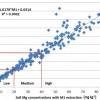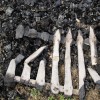 Soil testing is a multistep process starting with the collection of a sample that adequately represents the area or field to be tested. Due to wide-ranging soil conditions across Florida and the United States, multiple soil test methods exist. During the 1970s, Florida along with several other southeastern US states adopted Mehlich-1 (M1) as the official extractant for acidic soils. The UF/IFAS Plant Nutrient Oversight Committee approved the change from M1 to M3 in 2010. Based on observations of the interpretations, the technical committee revised the M3 interpretation in March 2014. The new interpretations have been correlated with the M1 interpretations, as closely and realistically as possible, so the actual nutrient recommendations are not changed. This 7-page fact sheet was written by Rao Mylavarapu, Tom Obreza, Kelly Morgan, George Hochmuth, Vimala Nair, and Alan Wright, and published by the UF Department of Soil and Water Science, May 2014.
Soil testing is a multistep process starting with the collection of a sample that adequately represents the area or field to be tested. Due to wide-ranging soil conditions across Florida and the United States, multiple soil test methods exist. During the 1970s, Florida along with several other southeastern US states adopted Mehlich-1 (M1) as the official extractant for acidic soils. The UF/IFAS Plant Nutrient Oversight Committee approved the change from M1 to M3 in 2010. Based on observations of the interpretations, the technical committee revised the M3 interpretation in March 2014. The new interpretations have been correlated with the M1 interpretations, as closely and realistically as possible, so the actual nutrient recommendations are not changed. This 7-page fact sheet was written by Rao Mylavarapu, Tom Obreza, Kelly Morgan, George Hochmuth, Vimala Nair, and Alan Wright, and published by the UF Department of Soil and Water Science, May 2014.
http://edis.ifas.ufl.edu/ss620
Tag: Vimala D. Nair
An Introduction to Biochars and Their Uses in Agriculture
 Biochar, also known as black carbon, is a product derived from organic materials rich in carbon and is found in soils in very stable solid forms, often as deposits. In recent years, considerable research has focused on biochar, its nature, and its properties to explore its potential benefits and negative impacts, particularly for applying to agricultural fields as amendments. This publication provides a general description of biochar, as well as technical details, benefits, and disadvantages of biochar for agricultural and environmental uses. This 4-page fact sheet was written by Rao Mylavarapu, Vimala Nair, and Kelly Morgan, and published by the UF Department of Soil and Water Science, August 2013.
Biochar, also known as black carbon, is a product derived from organic materials rich in carbon and is found in soils in very stable solid forms, often as deposits. In recent years, considerable research has focused on biochar, its nature, and its properties to explore its potential benefits and negative impacts, particularly for applying to agricultural fields as amendments. This publication provides a general description of biochar, as well as technical details, benefits, and disadvantages of biochar for agricultural and environmental uses. This 4-page fact sheet was written by Rao Mylavarapu, Vimala Nair, and Kelly Morgan, and published by the UF Department of Soil and Water Science, August 2013.
http://edis.ifas.ufl.edu/ss585
The Potential for Plants to Remove Phosphorus from the Spodic Horizon (SL359/SS560)
 Under what conditions can plants be used to remove phosphorus from common Florida soils? This 5-page fact sheet shows how calculations for the phosphorus saturation ratio and soil phosphorus storage capacity at various soil depths can be used to determine whether to use phytoremediation as a strategy to remove phosphorus from the soil. Written by D. Chakraborty, V.D. Nair, W.G. Harris, and R.D. Rhue, and published by the UF Department of Soil and Water Science, October 2011.
Under what conditions can plants be used to remove phosphorus from common Florida soils? This 5-page fact sheet shows how calculations for the phosphorus saturation ratio and soil phosphorus storage capacity at various soil depths can be used to determine whether to use phytoremediation as a strategy to remove phosphorus from the soil. Written by D. Chakraborty, V.D. Nair, W.G. Harris, and R.D. Rhue, and published by the UF Department of Soil and Water Science, October 2011.
http://edis.ifas.ufl.edu/ss560
The Long-term Contribution of Phosphorus from Agricultural Lands to Lake Okeechobee (SL357/SS558)
 This 7-page fact sheet uses a new procedure to evaluate the soil from active and abandoned dairies in the Lake Okeechobee watershed to determine their potential to negatively impact water quality through phosphorus release. Written by V.D. Nair, M. Chrysostome, and W.G. Harris, and published by the UF Department of Soil and Water Science, October 2011.
This 7-page fact sheet uses a new procedure to evaluate the soil from active and abandoned dairies in the Lake Okeechobee watershed to determine their potential to negatively impact water quality through phosphorus release. Written by V.D. Nair, M. Chrysostome, and W.G. Harris, and published by the UF Department of Soil and Water Science, October 2011.
http://edis.ifas.ufl.edu/ss558
Phosphorus Sources and Risk Potential: Organic and Inorganic Fertilizers (SL358/SS559)
 One of the factors that determines whether a source of phosphorus will have a negative impact on water quality is solubility. This 3-page fact sheet discusses the significantly different solubility of commonly found phosphorus sources in Florida. Written by V.D. Nair and W.G. Harris, and published by the UF Department of Soil and Water Science, October 2011. (UF/IFAS photo by Milt Putnam)
One of the factors that determines whether a source of phosphorus will have a negative impact on water quality is solubility. This 3-page fact sheet discusses the significantly different solubility of commonly found phosphorus sources in Florida. Written by V.D. Nair and W.G. Harris, and published by the UF Department of Soil and Water Science, October 2011. (UF/IFAS photo by Milt Putnam)
http://edis.ifas.ufl.edu/ss559
SL336/SS541 Understanding Soil Phosphorus Storage Capacity
SL336, a 4-page illustrated fact sheet by Vimala D. Nair, Willie G. Harris, Debolina Chakraborty, and Myrlène Chrysostome, presents an approach to assessing sandy soil phosphorus (P) assimilation capacity prior to reaching a threshold of environmental concern. Includes references. Published by the UF Department of Soil and Water Science, November 2010.
http://edis.ifas.ufl.edu/ss541
SL333/SS539 An Indicator for Risk of Phosphorus Loss from Sandy Soils
SL333, a 3-page illustrated fact sheet by Vimala D. Nair, Willie G. Harris, and Debolina Chakraborty, describes a practical means of determining when a soil has reached a level of P loading that constitutes an environmental risk. Includes references. Published by the UF Department of Soil and Water Sciences, October 2010.
http://edis.ifas.ufl.edu/ss539
AE443 Greenhouse Gas Mitigation in Forest and Agricultural Lands: Reducing Emissions
AE443, a 7-page fact sheet by Solomon G. Haile, Clyde W. Fraisse, P.K. Ramachandran Nair and Vimala D. Nair, is part of the Greenhouse Gas Mitigation in Forest and Agricultural Lands series. It provides basic information about greenhouse gases (GHGs), the greenhouse effect, and global warming, and sources of GHG emissions from forest and agricultural lands and discusses land management practices that have potential to reduce GHG emissions in the agricultural and forestry sectors of Florida. Includes refererences. Published by the UF Department of Agricultural and Biological Engineering, December 2008.
http://edis.ifas.ufl.edu/AE443
AE435 Greenhouse Gas Mitigation in Forest and Agricultural Lands: Carbon Sequestration
AE435, an 8-page fact sheet by Solomon G. Haile, Clyde W. Fraisse, Vimala D. Nair, and P.K. Ramachandran Nair, addresses some basic questions regarding the prospects of carbon (C) sequestration in forest and agricultural lands and examines the C sequestration potential of different land management practices that could play a role in GHG mitigation strategies. Includes references. Published by the UF Department of Agricultural and Biological Engineering, September 2008.
http://edis.ifas.ufl.edu/AE435